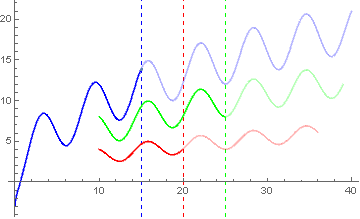If the same threshold applies to all plots, you can add the options Mesh and MeshShading to p1, p2 and p3 and use the option GridLines in Show:
DynamicModule[{a1 = 1, a2 = 2, a = 3, b1 = 1, b2 = 2, b = 3,
lag1 = 26, lag = 30, time1 = 40, time2 = 36, time3 = 39},
p1 = Plot[a Sqrt[x] - b Cos[x], {x, 0, time1},
PlotStyle -> Blue, Mesh -> {{15}},
MeshShading -> {Opacity[1], Opacity[0.3]}];
p2 = Plot[a1 Sqrt[x] - b1 Cos[x], {x, time1 - lag, time2},
PlotStyle -> Red, Mesh -> {{15}},
MeshShading -> {Opacity[1], Opacity[0.3]}];
p3 = Plot[a2 Sqrt[x] - b2 Cos[x], {x, time2 - lag1, time3},
PlotStyle -> Green, Mesh -> {{15}},
MeshShading -> {Opacity[1], Opacity[0.3]}];
Show[p1, p2, p3, GridLines -> {{15}, None},
GridLinesStyle -> Directive[Gray, Dashed], PlotRange -> All]]

An alternative trick is to add a semi-transparent rectangle as Epilog:
With[{a1 = 1, a2 = 2, a = 3, b1 = 1, b2 = 2, b = 3, lag1 = 26,
lag = 30, time1 = 40, time2 = 36, time3 = 39},
p1 = Plot[a Sqrt[x] - b Cos[x], {x, 0, time1}, PlotStyle -> Blue];
p2 = Plot[a1 Sqrt[x] - b1 Cos[x], {x, time1 - lag, time2}, PlotStyle -> Red];
p3 = Plot[a2 Sqrt[x] - b2 Cos[x], {x, time2 - lag1, time3}, PlotStyle -> Green];
Show[p1, p2, p3,
Epilog -> {Opacity[.8, White], Rectangle[{15, .5}, {40, 40}]},
GridLines -> {{15}, None},
GridLinesStyle -> Directive[Gray, Dashed], PlotRange -> All]]

You can also use the option ColorFunction:
twoToneCF[t_, color_] := If[# <= t, color, Opacity[.3, color]] &;
DynamicModule[{a1 = 1, a2 = 2, a = 3, b1 = 1, b2 = 2, b = 3,
lag1 = 26, lag = 30, time1 = 40, time2 = 36, time3 = 39, threshold = 15},
p1 = Plot[a Sqrt[x] - b Cos[x], {x, 0, time1}, Mesh -> {{15}},
ColorFunctionScaling -> False,
ColorFunction -> twoToneCF[threshold, Blue]];
p2 = Plot[a1 Sqrt[x] - b1 Cos[x], {x, time1 - lag, time2},
ColorFunctionScaling -> False,
ColorFunction -> twoToneCF[threshold, Red]];
p3 = Plot[a2 Sqrt[x] - b2 Cos[x], {x, time2 - lag1, time3},
ColorFunctionScaling -> False,
ColorFunction -> twoToneCF[threshold, Green]];
Show[p1, p2, p3, GridLines -> {{threshold}, None},
GridLinesStyle -> Directive[Gray, Dashed], PlotRange -> All]]

Update: We can use the last approach to have different thresholds in the three plots:
DynamicModule[{a1 = 1, a2 = 2, a = 3, b1 = 1, b2 = 2, b = 3,
lag1 = 26, lag = 30, time1 = 40, time2 = 36, time3 = 39,
thresholds = {15, 20, 25}},
p1 = Plot[a Sqrt[x] - b Cos[x], {x, 0, time1}, Mesh -> {{15}},
ColorFunctionScaling -> False,
ColorFunction -> twoToneCF[thresholds[[1]], Blue]];
p2 = Plot[a1 Sqrt[x] - b1 Cos[x], {x, time1 - lag, time2},
ColorFunctionScaling -> False,
ColorFunction -> twoToneCF[thresholds[[2]], Red]];
p3 = Plot[a2 Sqrt[x] - b2 Cos[x], {x, time2 - lag1, time3},
ColorFunctionScaling -> False,
ColorFunction -> twoToneCF[thresholds[[3]], Green]];
Show[p1, p2, p3,
GridLines -> {Thread[{thresholds, {Blue, Red, Green}}], None},
GridLinesStyle -> Directive[Gray, Dashed], PlotRange -> All]]

An aside: You might want top play with ConditionalExpression and Piecewise to get all three plots using a single Plot.





